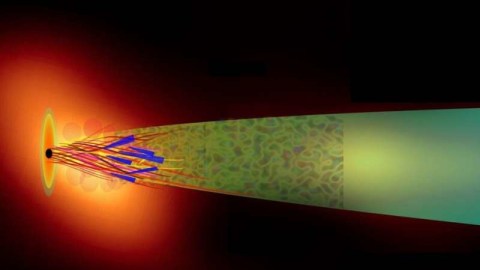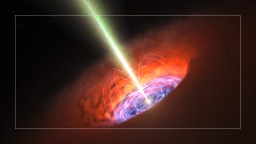Study: spinning black holes power jets with magnetic reconnection

Credit: Amit Shukla
- New research discovers what mechanism powers radiation jets from blazars.
- Scientists found that magnetic reconnection is responsible for boosting the cores of the jets.
- The study’s conclusion is like deciphering a “hieroglyph in the black hole alphabet,” says author.
A new study sheds light on the hidden mechanisms propelling plasma jets that shoot out from spinning black holes.
One of the most dramatic space events occurs when a black hole powers up a blazar, a region of space producing a huge jet of radiation streaming towards Earth. These can reach hundreds of thousands of light years into space.
What’s unusual, scientists noticed, is that while we can see the jet, the black hole emitting it stays hidden. All we can gauge about its existence is a shadow courtesy of bent light rays near the black hole. The jet’s core, however, appears to be located at the distance of over a thousand times the shadow, prompting the question – how did it get there? How does the energy from the black hole reach the jet’s core? And where does the energy for the blast of particles come from in the first place?
Using NASA’s space telescope Fermi-LAT to observe quasar 3C279 (also housing a black hole), astrophysicist Amit Shukla found that the jet’s core, located in the millimeter wavelength range, emits high-energy gamma radiation that constantly flickers, its brightness able to double within a few minutes. This pattern of changes corresponds to the process of magnetic reconnection, spotted in astrophysical objects that have strong magnetic fields, as reports the press release on the study. This process can also be influenced by solar activity.
While reconnection is taking place, invisibly stored energy is released from the magnetic field in the form of “mini-jets”. Accelerated particles within these jets are responsible for the observed gamma radiation.
Blazars Explained: The Most Energetic Objectswww.youtube.com
Shukla, currently of the Indian Institute of Technology in Indore, India, conducted a part of the research while working at the Julius-Maximilians-Universität (JMU) Würzburg in Bavaria, Germany.
“I saw how the analysis of the data revealed the special pattern of magnetic reconnectionin the light curve,” explained Shukla. “It felt as if I had suddenly deciphered a hieroglyph in the black hole alphabet.”
Professor Karl Mannheim, head of the JMU Chair of Astronomy and co-author of the paper, shared that spacetime near the black hole they examined is “forced to swirl around” in so-called “corotation.” He further elucidated the events, highlighting that “Magnetic fields anchored to the plasma around the black hole expel the jet slowing down the black hole’s rotation and converting part of its rotational energy into radiation.”
Check out their study published in Nature Communications.





